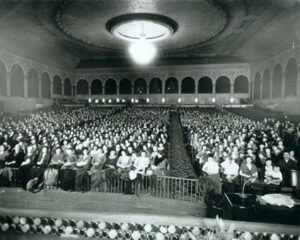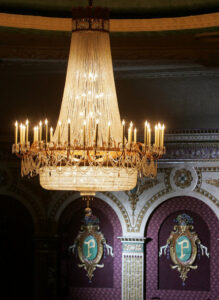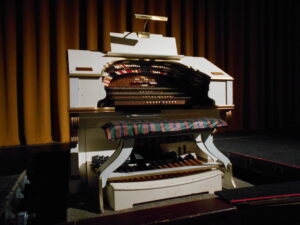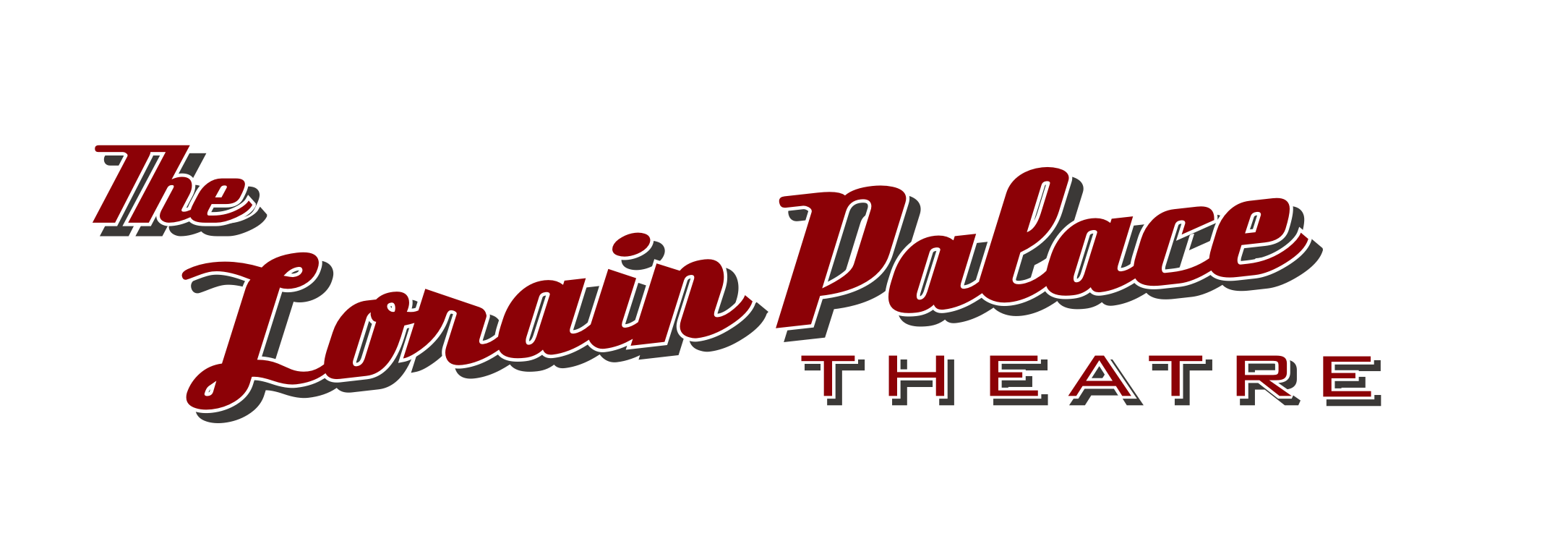The Lorain Palace Civic Center
The Birth of a Dream
1928-Present
Construction
After the devastating tornado of 1924, the largest one-floor theater in the State of Ohio would serve as the cornerstone for a new Lorain. The exterior of the Palace was designed in Gothic style with a facade of terra cotta and elaborately cut stone, while the inside was reminiscent of the Italian Renaissance. Both the inner and outer lobbies boasted ornate sculptured ceilings elegantly painted in soft shades of turquoise and coral and highlighted in gold, and the graceful domed ceiling of the main auditorium featured an exquisite three-quarter-ton crystal chandelier.
The Palace also boasted a fireproof projection room and two Peerless Simplex projection machines. These machines allowed pictures to be run continuously without a break for re-winding. The 28—100 foot stage contained 23 sets of lines for flying scenery, making it suitable for charity and vaudeville shows and the full orchestra pit was accessible from both the main seating area and the basement.
Money was no object; the total cost of construction and equipment was $500,000.

Opening Night: April 19, 1928
Patrons flocked into the Palace’s 1720 upholstered leather seats to watch a talking movie for the first time and were treated to a film resume of world events. They viewed a comedy and novelty reel, followed by Syd Sampliner and his Palace Concert Orchestra, and three acts of vaudeville. The spotlight then moved to the Mighty Wurlitzer Organ as it rose from below the stage, thrilling the audience with its pulsating crescendos. Finally, the new film, a pre-release of Paramount’s silent comic film “Something Always Happens” starring Neil Hamilton and Esther Ralston flashed on the screen. The program ended with a finale by the Palace Concert Orchestra Theatre. The program for the opening night took over eight months to program and was done so by the Variety Amusement Company which owned and operated the Palace for many years.
The 30’s and 40’s
The advent of talking pictures required some changes both for theatre operators and patrons. One program from the early days of the Palace admonishes the audience to refrain from unnecessary loud conversation while entering or leaving the theatre and demands, absolute silence so the Talkies could be understood and enjoyed by everyone. It also noted the Gentlemen’s Smoking Rooms just off the main foyer.
The full program of seven units listed for the opening night appears to have continued for a number of years (news, a comedy, a short subject, the Palace Orchestra, 2 or 3 acts of vaudeville, the Mighty Wurlitzer, a talking pictures, and orchestra finale). Live music, constantly being adapted to the action on stage, did much to heighten the excitement of the performances, be they singers, acrobats, comedians, dancers, animal acts or magicians. The program changed twice a week with variances for legitimate shows. There were continuous performances from noon until 11:00 PM, seven days a week. During the Depression, movies and vaudeville were a great escape from the harsh realities of the times. People flocked to movie houses across the country.
During World War II there were several special live shows to promote the sale of War Bonds. From 1944 on, the Palace was almost exclusively a movie theatre. It gradually suffered the same decline as other entertainment palaces around the country, but one thing was different. Lorain’s Palace never closed.
The 70’s
A Civic Center Committee was appointed in June 1972 by Lorain Mayor Joseph J. Zahorec. This four-woman group was created to do preliminary studies to determine the need, interest, and possible support for a civic center. Results pointed in one direction, that of a growing need for a center with a major focus on community-wide activities in the deteriorating downtown area.
Combined with the assistance of the Lorain Community Development Department and monies from numerous civic groups and individuals, the committee became incorporated as Lorain Civic Center Committee, Inc. a non-profit organization.
In 1974, Civic Center Madness, a major fundraising project, took place in the urban renewal area of North Broadway. Forty civic groups participated in this week-long street fair. Stores soon to be torn down were converted as if by magic into an old-fashioned ice cream parlor, a Second-Hand Rose shop, a casino, a book and plant store, an open-air barbecue, international shops, etc. The Saturday night Great Gatsby Party at the Palace climaxed the week’s activities.
On March 1st, 1975, with the support of the city government, the Civic Center Annex was opened at 319 Broadway to serve as a temporary headquarters for meetings and fundraising projects. In the months that followed, the people of the city pitched in to scrub, repair, and paint the Annex. Scores of talks were given to clubs and organizations to spark interest in and support for a community center. Artists, hobbyists, craftsmen, culinary buffs, and citizens from all walks of life rented booths and sold their wares and brought increased activity to the downtown area.
With the threatened demolition of the Palace Theatre and an advantageous purchase price, the Committee felt this historic building could be the focal point for the renovation of downtown Lorain. The building was structurally sound as it had been designed and constructed with every effort toward making it tornado-proof. It had steel-reinforced concrete walls and a sturdy roof. The skillfully molded ceilings and interior walls displayed a craftsmanship seldom found today. Much of the original equipment was still usable. The crystal chandelier, the Wurlitzer pipe organ (one of only four remaining in theatres across Ohio), and the two spacious loges, are just some of the features which made this building worthy of being preserved.
Twenty-five thousand dollars was tendered as a down payment toward the purchase of the $100,000 building. A capital funds campaign was launched and in May of 1977 the Palace Theatre building was purchased and a grand opening was held.
More talks to civic groups followed more months of scrubbing, repairing and painting, this time at the Palace. Individuals and groups came forth to aid in the renovation of this once beautiful structure.
December 10th, 1977 was a landmark date. On the stage of the theatre that night following a Christmas musical program, the mortgage was burned ceremoniously, thanks to the generosity of many groups and individuals.
With the Palace owned free and clear, the Committee set forth on its program to restore both the interior and exterior of the building.
INTERESTING HISTORICAL FACTS/STATS/INFORMATION ABOUT THE LORAIN PALACE THEATRE
THEATRE:
– The theatre was built in 1928. Four years after the great tornado hit Lorain. It was owned and operated by Warner Brothers.
– The decor above the proscenium arch are not coffin lids!
– The same decor can be found throughout the country.
– In 1928 the theatre was the largest one-floor theatre in the State of Ohio.
– The first theatre in the State of Ohio with talking motion pictures and we still have the original amplifier.
– First fireproof projection booth in the State of Ohio.
– Manual sprinkler system for the State that was also a first.
– The theatre has never closed. It has gone through hard times but has never closed.
EXTERIOR:
– The exterior was restored to its original appearance in the years 2011 and 2012. A ceramic tile overlay put on in the late 70s was removed and the original cast and glazed terracotta were repaired. New pieces were cast to replace missing or badly damaged units at a cost of $68,000.00
– The exterior lobby ceiling has been restored to its original height and appearance at a cost of $12,000.00.
– In 2010 all of the storefront glass and doors were replaced to more closely resemble the original appearance. Cost $15,000.00.
– All of these repairs have been made possible through a cultural facilities grant by the State of Ohio.

CHANDELIER:- The chandelier weighs ¾ of a ton and was made especially for the theatre.
– It has 87, 40-watt bulbs.
– In 2014 we launched a Go Green campaign to raise money to replace the bulbs with L.E.D. bulbs. The bulbs were all replaced that same year.
– No, the chandelier has never fallen.
– The crystals seen are Yugoslavian cut crystals.
– The bottom basket of the chandelier is the heart of our state-of-the-art emergency lighting system to safely exit the theatre in case of an emergency.
– In 1977 when the Civic Center Committee was in negotiations to purchase the theatre from Stern Theater Company of Ohio they wanted to take the chandelier. The Civic Center Committee said absolutely not!
– Many historical items were removed from the theatre including the original chandeliers in the outer lobby and the marquee windows that announced the upcoming shows.
THEATRE SEATS:
– In 1928 the theatre seated 2000 patrons.
– In 1977 there were 1573 permanent seats.
– In 1991 the theatre seats were taken out leaving just the decorative end irons. We then expanded the back-to-back seat depth for taller people leaving us with 1441 permanent seats.
STAGE:
– Until 1979, the stage changed very little from what it was like in 1928.
– Sandbags were being used as counterweights and the batten bars which hold the curtains had not been replaced since 1928.
– The first major restoration project was to put in a counterweight system and expand the fly system allowing us to handle most major shows at a cost of $260,000.00.
– In 1980 the curtains cost us $35,000.00
– A new screen to accommodate the new digital 3D system was installed in the winter of 2011. This is now the largest near I-Max screen in the State of Ohio.
DRESSING ROOMS:
– In the spring of 2001, the Palace spent $85,000.00 to upgrade the dressing rooms.
BASEMENT:
– The basement area is where the orchestras would gather back in 1928.
– The first room to the right is the conductor’s room.
– The restroom was for men only.
– There were no women in the orchestras back in 1928.
– Presently, we use the basement for massive gatherings for some of the choirs and larger groups.
– This is now a brighter and more professional-looking dressing room facility.

WURLITZER ORGAN:
– Behind the grill work is the pipe for the Mighty Wurlitzer.
– At one time the Wurlitzer was vandalized, but we were able to repair it.
– In 1977 a group came in and cleaned and reworked the organ and have voluntarily continued to repair it over the years.
– A shipping tag is still attached that states the organ was shipped by Wurlitzer to the Palace on February 25th, 1928, and an inspection form, dated April 1928, states that it was installed correctly.
– In 2014 the organ lift was repaired and began operating again.
WALL PANELS:
– In 1931 wall panels were installed when it looked like talking pictures were going to be around for a long time.
– With all the plaster exposed, the sound just rattled around in the theatre, so these panels were installed to help the acoustics.
– The exposed panels you see are the original colors of salmon, turquoise, ivory, and gold.
– Eventually, we hope to replace the lights behind the walls that circle the two rims and have them running all the time.
– The Palace is noted for having over 5000 light bulbs!
CEILING:
– In 1991 when all the old theatre seats were removed, the ceiling was painted and sealed in one color as this was all we could afford.
PROJECTION BOOTH:
– Until 1996, the projection booth was like walking back into the 1930s and 1940s. Very little has changed to this date.
– When you have an opportunity to look at our museum display, you will see what it looked like right up until December 1st, 1996.
– It took two projectors to show one movie. The old projectors are still on display in the marble lobby.
– Also displayed are old RCA amplifiers. These were put in the theatre during the 1950s and have tubes in them.
– We have modified the projection booth and replaced the 1996 platter system. The amplifiers are now located below the stage and are 16,500 watts. We use Dolby Mono, Dolby A, Dolby SR, Dolby Digital, and Dolby DTS. The entire project including the electrical revamping came to just over $96,000.00.
– In the museum, you will see 18†of film that passed through the projector every second with 24 frames per second. The bulb is so bright, at 4500 watts, the frame has to be water-cooled or it will instantly melt the film down to a piece of nylon string!
-A new digital 3D system replaced the film. Movies are now loaded onto a single hard drive that is inserted into our new projector. This looks like a large PowerPoint projector.
LOBBY AREAS:
– The first lobby when you enter the theatre is a marble lobby with one-foot marble squares about 3 inches thick. When we first took the theatre over in 1977, everyone thought it was a linoleum floor and that we brought a chemical company out to clean it. Yes, it is REAL marble.
– The mirrored lobby is where you will find our main concession counter. This counter was renovated, relocated and widened in 2012 for more efficient use. This concession counter was originally at the Three Cheers Bar at Heilman’s Restaurant. It was saved from the wrecking ball by our City Council and with their permission, the counter now resides here at the Palace.
– Until the early 1950s there were no concession counters or stands in historic theatres. People could buy pop, popcorn, and nuts at the “Nut Hut†which was right next door, where our park area is now located.
